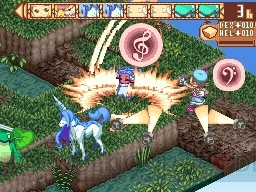|
|

|
PLATFORM
|
DS
|
BATTLE SYSTEM
|

|
INTERACTION
|

|
ORIGINALITY
|

|
STORY
|

|
MUSIC & SOUND
|

|
VISUALS
|

|
CHALLENGE
|
Easy
|
LANGUAGE BARRIER
|
High
|
COMPLETION TIME
|
20-40 Hours
|
|
OVERALL

|
+ Strong character interaction.
+ Some good plot twists.
+ Wide variety of equipment.
- Needs more enemy variety.
- The AI largely isn't.
|
Click here for scoring definitions
|
|
|
Tactics Layer - The Litinagard Chronicle is a title that I'd been curious about for a long time, but had never had the chance to acquire. A mid-spring lull in my gaming schedule seemed like a good time to pick it up. The experience was about what I expected -- quirky, memorably, and slightly embarrassing.
Once upon a time, there were three worlds: the paradise of Litinagard, the wasteland of Putragard, and Salasgard, a.k.a. the Earth. Monsters from Putragard invaded paradise, and only through the help of two warriors from Salasgard were the defenders able to stave off the hordes. Time flowed on, and the incursions began anew. Salasgard is no longer the same world it used to be, though, and a new type of savior was needed, with a new power -- cosplaying.
Story is one of Tactics Layer's strong points, as it borrows and adapts most of the tropes of the Japanese social-sim genre. Much like Sakura Taisen or the later Persona games, time is set aside each day for a limited number of social interactions. Many of these support or advance the current plot while the rest usually involve recruitment of side-characters. Most of the plot for the first half of the game is centered on character interactions at school, to the point where the monster-of-the-week fantasy aspect feels formulaic and the student body president is a better villain than the demon lords. About halfway through the game the balance of the story has an abrupt shift with the fantasy portion going into high gear, and it even succeeds in throwing a few good twists at the player. That's provided the player can read it, or course. The game's text is about a junior high school level and the story is told with splash pages and talking heads, so body language won't help any.
 We got the beat!
We got the beat!
|
|
That last part is something of a shame, as the game's sprites are well-articulated and fully capable of showing plot actions on their own. While overall the game's graphics aren't anything to write home about -- not to mention some minor but annoying graphical glitches -- the sprites for the fighting characters are all fairly distinctive and the cosplay outfits moreso. As one final touch, the battle sprites actually jiggle in all the right spots as they move in place.
This only highlights the fact that Ninja Studio was well aware of who its target audience is -- drooling fanboy otaku. Why else turn an equipment menu into a dress-up game? Or turn a beauty pageant mini-game into both a plot point and a major source of new equipment? Not to mention how the player's choice of events later in the game impacts which of the game's five heroines ends up as the main character's love interest.
Battles in Tactics Layer follow the tried-and-true standard of isometric tactical games. Anyone with the least amount of experience in the genre will have no trouble navigating the field of battle. Veterans will probably find regular combat to be much too easy, as enemies do not scale to the player's levels in story battles and the game's AI leaves much to be desired. Monsters may or may not take advantage of terrain and positions, usually not. Sometimes they won't do anything, opting to wait a round for a better position in the command line, regardless of how many player characters are within prime monster-whacking range.
The game's primary quirk, and the thing that makes combat interesting, is the class system. Instead of the usual selection of job classes, the main character (a teenage boy) is instructed to dress the fighting characters (all female, ranging from early teens to late thirties) in a wide assortment of garments. This can be done piecemeal to maximize certain stats or as entire ensembles. Skills are tied to specific combinations of equipment that are usually (but not always) included in the same cosplay ensemble. Approximately fifty of the game's seventy cosplay outfits are available on a player's first run through the game, with more becoming available on the new-game-plus mode and through wi-fi connectivity. They range from regular school and sports wear to fetish wear that is uniquely Japanese. A range of costumes references fictitious parodies of popular anime, while three are actually taken from other D3 titles, such as Onechanbara.
 No ruler attacks, unfortunately.
No ruler attacks, unfortunately.
|
|
Even with all this variety, there are limits. Each character can learn up to forty skills at a maximum, though there's an option to delete items from their memory. Of these, only four can be prepared for any given battle. Unfortunately, the limited number of enemy types (nine generic, nine special) and the aforementioned issues with enemy AI lessen the need to put much thought into skill setups, especially for the status-healing abilities.
The sound track in Tactics Layer is a bit of a mixed bag, as some of the tracks are excellent while others are merely annoying and repetitive. They all do a decent job of conveying the appropriate mood for the scene, so the game's tunes must be considered a success in that light. Still, this not one to buy the CD for.
Taken as either a tactical title or a dating sim Tactics Layer is fun but not incredibly remarkable. By combining the two genres the way they have, D3 and Ninja Studios have produced a title that could have been excellent with a little more work. While it doesn't live up to its potential, it certainly has left its mark in my brain, and will go down as my official guilty pleasure of 2010.
Review Archives
|









